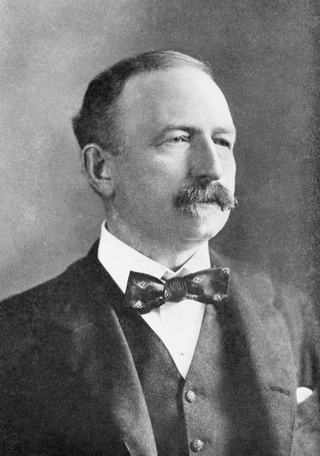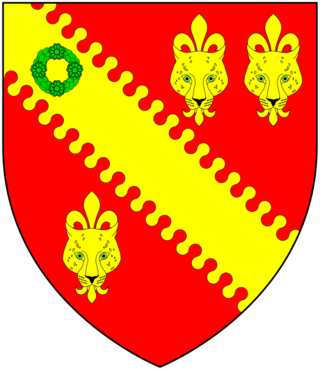Arms
  |
|
Baron Milne, of Salonika and of Rubislaw in the County of Aberdeen, is a title in the Peerage of the United Kingdom. [1] It was created on 26 January 1933 for Field Marshal Sir George Milne. He had previously served as Chief of the Imperial General Staff. As of 2009 the title is held by his grandson, the third Baron, who succeeded his father in 2005.
The heir presumptive is the present holder's brother, the Honourable Iain Charles Luis Milne FCA (b. 1949)
The heir presumptive's heir apparent is his elder son Iain Eduardo Alexander Milne (b. 1990).
  |
|

Earl of Macclesfield is a title that has been created twice. The first creation came in the Peerage of England in 1679 in favour of the soldier and politician Charles Gerard, 1st Baron Gerard. He had already been created Baron Gerard, of Brandon in the County of Suffolk, in 1645, and was made Viscount Brandon, of Brandon in the County of Suffolk, at the same time as he was given the earldom. These titles are also in the Peerage of England. Lord Macclesfield was the great-grandson of the distinguished judge Sir Gilbert Gerard, Master of the Rolls from 1581 to 1594. He was succeeded by his eldest son, the second Earl. He was involved in the Rye House Plot of 1683, was sentenced to death but later pardoned by the King. On his death without legitimate issue in 1701 the titles passed to his younger brother, the third Earl. He had earlier represented Yarmouth, Lancaster and Lancashire in the House of Commons. When he died in 1702 the titles became extinct.
Viscount Rochdale, of Rochdale in the County Palatine of Lancaster, is a title in the Peerage of the United Kingdom. It was created on 20 January 1960 for John Kemp, 2nd Baron Rochdale. He was Chairman of the woollen manufacturing firm of Kelsall & Kemp Ltd and a former President of the National Union of Manufacturers and Governor of the BBC. The title of Baron Rochdale, of Rochdale in the County Palatine of Lancaster, was created in the Peerage of the United Kingdom on 14 February 1913 for his father, George Kemp. He was Chairman of Kelsall & Kemp Ltd, a Brigadier-General in the Army, and former Member of Parliament for South East Lancashire and Manchester North West. As of 2022 the titles are held by his grandson, the third Viscount, who succeeded his father in 2015.

Baron Hardinge of Penshurst, in the County of Kent, is a title in the Peerage of the United Kingdom. It was created in 1910 for the diplomat the Hon. Sir Charles Hardinge, Viceroy and Governor-General of India from 1910 to 1916. He was the second son of Charles Hardinge, 2nd Viscount Hardinge. His son, the second Baron, served as private secretary to both King Edward VIII and King George VI.
Baron Hives, of Duffield in the County of Derby, is a title in the Peerage of the United Kingdom. It was created 7 July 1950 for the Ernest Hives, Chairman of Rolls-Royce Ltd. As of 2010 the title is held by his grandson, the third Baron, who succeeded his uncle in 1997.
Baron Gainford, of Headlam in the County Palatine of Durham, is a title in the Peerage of the United Kingdom. It was created on 3 January 1917 for the Liberal politician Jack Pease, a member of the Darlington Pease family. He notably served as President of the Board of Education from 1911 to 1915. Pease was the second son of Sir Joseph Pease, 1st Baronet, and the grandson of Joseph Pease, while Arthur Pease was his uncle and Sir Arthur Pease, 1st Baronet, Beaumont Pease, 1st Baron Wardington, and Herbert Pease, 1st Baron Daryngton, were his first cousins. The third baron was a former member of the London County Council and of the Greater London Council. As of 2013 the title is held by his younger brother, the fourth baron, an architect and town planner; County Planning Officer for Ross and Cromarty 1967–1975 and Scottish Office Inquiry Reporter 1978–1993.
Baron Gridley, of Stockport in the County Palatine of Chester, is a title in the Peerage of the United Kingdom. It was created on 10 January 1955 for the Conservative politician Sir Arnold Gridley, who had earlier represented Stockport and Stockport South in the House of Commons. As of 2010 the title is held by his grandson, the third Baron, who succeeded his father in 1996.

Baron Dowding, of Bentley Priory in the County of Middlesex, is a title in the Peerage of the United Kingdom. It was created on 5 July 1943 for the noted air commander Air Chief Marshal Sir Hugh Dowding. He was commander of the RAF Fighter Command during the Battle of Britain in 1940. As of 2010 the title is held by his grandson, the third Baron, who succeeded his father in 1992.
Baron Keyes, of Zeebrugge, and Dover in the County of Kent, is a title in the Peerage of the United Kingdom. It was created in 1943 for the prominent naval commander Admiral of the Fleet Sir Roger Keyes, 1st Baronet. He is chiefly remembered for his role in the Zeebrugge Raid in 1918, an attempt by the Royal Navy to neutralize the Belgian port of Zeebrugge which was used as a base for German submarine attacks on Allied shipping. Keyes had already been created a Baronet, of Zeebrugge, and of Dover in the County of Kent, in the Baronetage of the United Kingdom in 1919. As of 2010 the titles are held by his grandson, the third Baron, who succeeded his father in 2005. He does not use his title.
Baron Kenswood, of St Marylebone in the County of London, is a title in the Peerage of the United Kingdom. It was created in 1951 for the professional violinist and welfare worker for the blind, Ernest Whitfield. As of 2017 the title is held by his grandson, the third Baron, who succeeded in 2016.

Baron Wrenbury, of Old Castle, Dallington in the County of Sussex, is a title in the Peerage of the United Kingdom. It was created in 1915 for the barrister and judge Sir Henry Buckley. He served as a Judge of the High Court of Justice and as a Lord Justice of Appeal. As of 2014 the title is held by his great-grandson, the fourth Baron, who succeeded his father in 2014. The Hon. Sir Denys Buckley, younger son of the first Baron, was also a Judge of the High Court of Justice and Lord Justice of Appeal.

Baron Shaughnessy, of the City of Montreal in the Dominion of Canada and of Ashford in the County of Limerick, is a title in the Peerage of the United Kingdom. It was created in 1916 for the Milwaukee born businessman Thomas Shaughnessy, president of the Canadian Pacific Railway Company. He was succeeded by his eldest son, the second Baron, a Director of the CPR and of the Canadian Bank of Commerce. His son, the third Baron, was a businessman and was also active in the House of Lords. However, he lost his hereditary seat in parliament after the House of Lords Act 1999.

Baron Silsoe, of Silsoe in the County of Bedford, is a title in the Peerage of the United Kingdom. It was created on 18 January 1963 for the barrister Sir Malcolm Trustram Eve, 1st Baronet. He had already been created a Baronet, of Silsoe in the County of Bedford, on 18 January 1943. He was succeeded by his son, the second Baron. Known as David Silsoe, he was also a barrister. As of 2017 the titles are held by his son Simon, the third Baron, who succeeded in 2005.

Baron Piercy, of Burford in the County of Oxford, is a title in the Peerage of the United Kingdom. It was created on 14 November 1945 for the economist, financier and civil servant William Piercy. As of 2010 the title is held by his grandson, the third Baron, who succeeded his father in 1981.
Baron McNair, of Gleniffer in the County of Renfrew, is a title in the Peerage of the United Kingdom. It was created on 4 August 1955 for the lawyer and judge Sir Arnold McNair. He was the first President of the European Court of Human Rights. As of 2010 the title is held by his grandson, the third Baron, who succeeded his father in 1989.
Baron Brocket, of Brocket Hall in the County of Hertford, is a title in the Peerage of the United Kingdom. It was created on 19 January 1933 for the businessman Sir Charles Nall-Cain, 1st Baronet. He was chairman of the brewing firm of Robert Cain & Sons, which had been founded by his father Robert Cain. Before his elevation to the peerage, Nall-Cain had been created a baronet, of the Node, in 1921. His son, the second Baron, represented Wavertree in the House of Commons as a Conservative. As of 2017 the titles are held by the latter's grandson, the third Baron, who succeeded in 1967.

Baron Tennyson, of Aldworth in the County of Sussex and of Freshwater in the Isle of Wight, is a title in the Peerage of the United Kingdom. It was created in 1884 for the poet Alfred Tennyson. His son, the second Baron, served as Governor-General of Australia, and his grandson, the third Baron, as a captain for the English cricket team. On the death in 2006 of the latter's younger son, the fifth Baron, the line of the eldest son of the first Baron failed. The title was inherited by the late Baron's second cousin once removed, the sixth and present holder of the peerage. He is the great-grandson of Hon. Lionel Tennyson, second son of the first Baron.
Baron Crawshaw, of Crawshaw in the County Palatine of Lancaster and of Whatton in the County of Leicester is a title in the Peerage of the United Kingdom. It was created on 25 August 1892 for Sir Thomas Brooks, 1st Baronet. He notably served as High Sheriff of Lancashire in 1884. Brooks had already been created a baronet in the Baronetage of the United Kingdom, of Crawshaw Hall and Whatton House, on 9 February 1891. As of 2013 the titles are held by his great-grandson, the fifth Baron, who succeeded his elder brother in 1997.
Baron Catto, of Cairncatto in the County of Aberdeen, is a title in the peerage of the United Kingdom. The only hereditary peerage newly conferred during the reign of King Edward VIII, the barony was created on 24 February 1936 for the businessman, banker and public servant, Sir Thomas Catto, 1st Baronet. He had already been created a baronet, of Peterhead, on 5 July 1921. As of 2018 the titles are held by his grandson, the third baron, who succeeded his father in 2001.
Baron Rootes, of Ramsbury in the County of Wiltshire, is a title in the Peerage of the United Kingdom. It was created on 16 February 1959 for the businessman Sir William Rootes. He was head of the motor car manufacturer Rootes Ltd. As of 2010 the title is held by his grandson, the third Baron, who succeeded his father in 1992.
Baron Leighton of St Mellons, of St Mellons in the County of Monmouth, is a title in the Peerage of the United Kingdom. It was created on 25 January 1962 for the Welsh shipping magnate Sir Leighton Seager, 1st Baronet. He was the son of Sir William Henry Seager. Seager had already been created a Baronet, of St Mellons in the County of Monmouth on 1 July 1952. As of 2017 the titles are held by his grandson, the third Baron, who succeeded his father in 1998. As of 31 December 2016 the present Baronet has not successfully proven his succession and is therefore not on the Official Roll of the Baronetage, with the baronetcy considered dormant since 1998.